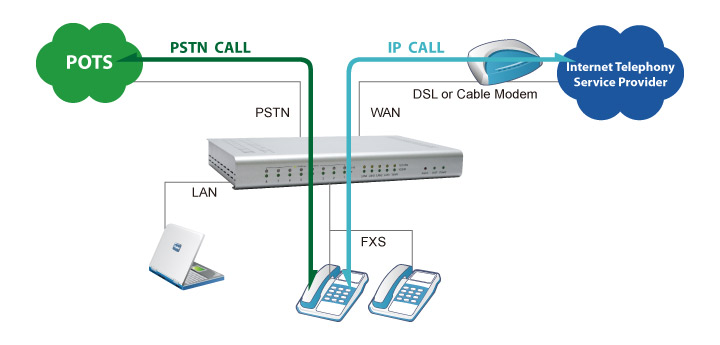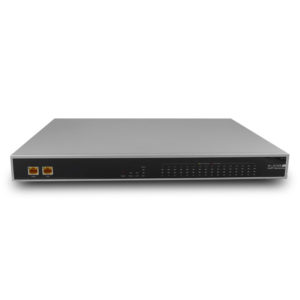Description
-
- RFC 3261 SIP protocol VoIP IAD
- 8 FXO, 8 FXS, and 5 Ethernet ports
- 1 WAN + 4 LAN, RJ-45 10/ 100/ 1000 Ethernet
- Interactive Voice Response (IVR)
- T.30 and T.38 compliant
- Line reversal and metering tone (12K/ 16KHz)
- Ethernet switch function with QoS and VLAN
- IGMP Proxy/ Snooping
- Advanced calling features, call parking and more
- WEB based configuration (HTTP/ HTTPs)
- TR-069, TR-104, DHCP Auto Provision
- SNMP V3/ V2c/ V1
- Busy Tone cadence auto learning/ detection
-
Model
- SP9880S: 8 FXS, 4 LAN, 1 WAN
- SP9880O: 8 FXO, 4 LAN, 1 WAN
- SP9880-8S80: 8 FXS, 8 FXO, 4 LAN, 1 WAN
- SP9880-8S8P: 8 FXS, 8 PSTN, 4 LAN, 1 WAN
Voice Feature
- G.722, G.711a/μ-law, G.729A/B, G.726, G.723.1
- DTMF Detection and Generation
- Silence Suppression & Detection
- Comfort Noise Generation (CNG)
- Voice Activity Detection (VAD)
- Echo Cancellation (G.165/G.168)
- Adaptive (Dynamic) Jitter Buffer
- Call progress tone detection (FXO) and generation (FXS)
- Auto or Programmable Gain Control
- Inbuilt Local Mixer
- ITU-T V.152 Voice-band Data over IP Networks
SIP Method Support
- ACK, BYE, CANCEL, INFO, INVITE, MESSAGE, NOTIFY, OPTIONS, PING, PRACK, PUBLISH, REFER, REGISTER, SUBSCRIBE, UPDATE
SIP Call Features
- Peer to Peer Call
- Call Hold / Retrieve
- Call Waiting
- Call Pick Up
- Call Park / Retrieve (with SIP Server)
- Call Forward – unconditional, busy, no answer
- Call Transfer – attended, unattended
- Do Not Disturb
- Speed Dialing
- Repeat Dialing
- Three-way Calling
- MWI (RFC-3842)
- Hot Line and Warm Line
SIP Call Management
- Support Outbound Proxy
- Support up to Four SIP servers
- SIP Registration Automatic Failover
- Group Hunting
- Privacy Mechanism /Private Extension to SIP
- Session Timers(Update / Re-invite)
- DNS SRV Support
- Call Types: Voice/ Modem/ FAX
- Call Routing by Prefix Number
- User Programmable Dial Plan Support
- Toll-Free Support
- Automatic Calling Number Manipulation (VoIP & FXO)
- CDR Client
- Manual Peer Table(for P2P calls)
- E.164 Numbering, ENUM support
SIP Account Management
- By port registration
- By device registration (share account)
- Mixed mode (Hunt number for inbound, by port number for outbound)
- Invite with Challenge
- Register by SIP Server IP Address or Domain Name
- Support RFC3986 SIP URI format
Physical Interface
- WAN: 1 x 10/100/1000M Ethernet, auto cross-over, auto speed negotiation, RJ-45
- LAN: 4 x 10/100/1000M Ethernet, auto cross-over, auto speed negotiation, RJ-45
- RJ-11 telephony connectors
- Power jack, Power switch
- Reset button
Telephony Specification
- In-Band DTMF, Out-of-Band DTMF Relay (RFC2833 or SIP INFO)
- DTMF/ PULSE Dial Support
- Caller ID Generation/ Detection:
- FXS metering pulse:
- Polarity Reverse Generation (FXS)
- T.30 FAX bypass, T.38 Real-Time FAX Relay
- FXS Line test and diagnostics with visual alarm indication
- Failsafe mechanism: FXS auto or manual relay to PSTN through
- hardware relay or internal PCM Bus while Network, Service or power failure occurs
- Emergency Number Table (PSTN)
- Modem over IP up to 14,4000bps
- ROH Tone (Receiver Off-Hook Tone @ 480 Hz)
- Loop Current Suppression
DTMF
FSK-Bellcore Type 1 & 2
FSK-ETSI Type 1 & 2
FSK-NTT
FSK: Calling Name, Number, Date and Time , VMWIPolarity Reversal
12kHZ calling tone
16kHZ calling toneInward Self Test:
.Loopback – codec
.Loopback – analogue
.SLIC DC power voltage
.Tip/ Ring DC feed
.RingerOutward Test (GR909 Standard):
.REN
.Phone Line disconnected
.H.F. DC Voltage (Hazardous and foreign DC Voltage)
.H.F. AC Voltage (Hazardous and foreign AC Voltage)
.Tip/ Ring ShortLED Indicators
- Power, Provision/Alarm, Register, WAN, LAN 1 ~ 4, Phone off-hook 1 ~ 8/ Phone Ch Alarm 1 ~ 8, Line 1 ~ 8
Accessories
- RJ11 cables
- RJ45 cables
- Power adaptor
General Information
- Dimensions: W 302 x D 179 x H 45 mm
- Weight: 1200g
- Power Source: AC 100~240V 50/60Hz input, DC 12V/2A output
- Operating temperature: 0°C ~ 45°C
- Storage temperature: -25°C ~ 75°C
- Operating Humidity : Up to 90% RH, non-condensing
NETWORK FEATURES AND MANAGEMENT
IP Network Specification
- WAN: Static IP, PPPoE, DHCP, PPTP
- Network Protocol Support:
- NAT Functions
- Support IPv4, IPv6 future upgradeable
- QoS Support:
- DDNS Support
- Route/ Bridge mode Support
IP, TCP, UDP, TFTP, FTP, RTP, RTCP, XR, ARP, RARP, ICMP, NTP, SNTP, HTTP, HTTPS, DNS, DNS SRV, Telnet, DHCP Server, DHCP Client, SNTU Client, UPnP, IGMP, IGMP snooping, IGMP proxy, RTSP ALG, SIP ALG
Support up to 255 clients
Port Forwarding (Virtual Servers)
DMZ
Port TriggeringWAN: DiffServ, IP Precedence
.Priority Queue
.Rate Control
.802.1Q (VLAN Tagging), 802.1P (Priority Tag)LAN: Rate Limit
Dyndns.org (Dynamic and Custom)
Network Security Specifications
- PPTP Client
- DIGEST Authentication
- MD5 Encryption
- DoS Protection
Management
- Web Based Configuration
- Auto-provisioning (HTTP/ HTTPS/ TFTP)
- Telnet
- IVR
- FTP/ TFTP/ HTTP Software Upgrade
- Configuration Backup and Restore
- Reset to Default Button
- TR-069, TR-104 (option)
- SNMP V3/ V2c /V1
- Two level (Admin/User) Web authority login
- System Information (Port /Registration status)
- System Log Client (General/ CDR/ SIP)
STANDARD COMPLIANCE
SIP, Voice and FAX Related Standard
- RFC1889 RTP: A Transport Protocol for Real-Time Applications
- RFC2543 SIP: Session Initiation Protocol
- RFC2833 RTP Payload for DTMF Digits, Telephony Tones and Telephony Signals
- RFC2880 Internet Fax T.30 Feature Mapping
- RFC2976 The SIP INFO Method
- RFC3261 SIP: Session Initiation Protocol
- RFC3262 Reliability of Provisional Responses in Session Initiation Protocol (SIP)
- RFC3263 Session Initiation Protocol (SIP): Locating SIP Servers
- RFC3264 An Offer/ Answer Model with Session Description Protocol (SDP)
- RFC3265 Session Initiation Protocol(SIP)-Specific Event Notification
- RFC3311 The Session Initiation Protocol (SIP) UPDATE Method
- RFC3323 A Privacy Mechanism for the Session Initiation Protocol (SIP)
- RFC3325 Private Extensions to the Session Initiation Protocol (SIP) for Asserted Identity within Trusted Networks
- RFC3362 Real-time Facsimile (T.38) – image/ t38 MIME Sub-type Registration
- RFC3515 The Session Initiation Protocol (SIP) Refer Method
- RFC3550 RTP: A Transport Protocol for Real-Time Applications. July 2003
- RFC3665 Session Initiation Protocol (SIP) Basic Call Flow Examples
- RFC3824 Using E.164 numbers with the Session Initiation Protocol (SIP)
- RFC3841 Caller Preferences for the Session Initiation Protocol (SIP)
- RFC3842 A Message Summary and Message Waiting Indication Event Package for the Session Initiation Protocol (SIP)
- RFC3891 The Session Initiation Protocol (SIP) “Replaces” Header
- RFC3892 The Session Initiation Protocol (SIP) Referred-By Mechanism
- RFC3960 Early Media and Ringing Tone Generation in the Session Initiation Protocol (SIP)
- RFC3986 Uniform Resource Identifier (URI): Generic Syntax
- RFC4028 Session Timers in the Session Initiation Protocol (SIP)
- Draft-ietf-sipping-service-examples-08 for call features
Network Related Standard
- RFC318 Telnet Protocols
- RFC791 Internet Protocol
- RFC792 Internet Control Message Protocol
- RFC793 Transmission Control Protocol
- RFC768 User Datagram Protocol
- RFC826 Ethernet Address Resolution Protocol
- RFC959 File Transfer Protocol
- RFC1034 Domain Names – concepts and facilities
- RFC1035 Domain Names – implementation and specification
- RFC1058 Routing Information Protocol
- RFC1157 Simple Network Management Protocol (SNMP)
- RFC1305 Network Time Protocol (NTP)
- RFC1321 The MD5 Message- Digest Algorithm
- RFC1349 Type of Service in the Internet Protocol Suite
- RFC1350 The TFTP Protocol (Revision 2)
- RFC1661 The Point-to-Point Protocol (PPP)
- RFC1738 Uniform Resource Locators (URL)
- RFC2854 The ‘text/ html’ Media Type
- RFC2131 Dynamic Host Configuration Protocol
- RFC2136 Dynamic Updates in the Domain Name System (DNS UPDATE)
- RFC2327 SDP: Session Description Protocol
- RFC2474 Definition of the Differentiated Services Field (DS Field)
- RFC2516 A Method for Transmitting PPP Over Ethernet
- RFC2616 Hypertext Transfer Protocol – HTTP/1.1
- RFC2617 HTTP Authentication: Basic and Digest Access Authentication
- RFC2637 Point-to-Point Tunneling Protocol
- RFC2766 Network Address Translation – Protocol Translation (NAT-PT)
- RFC2782 A DNS RR for Specifying the location of Services (DNS UPDATE)
- RFC2818 HTTP Over TLS (HTTPS)
- RFC2916 E.164 Number and DNS
- RFC3022 Traditional IP Network Address Translator
- RFC3489 STUN – Simple Traversal of User Datagram Protocol (UDP) Through Network Address Translators (NATs)
-



